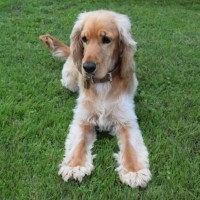Appearance of the Cocker Sheltie
|
| The Cocker Sheltie will be a medium-sized dog with a long, dense double coat. The Cocker Sheltie can be seen in a variety of colors such as merle, tricolor, black, brown, beige and white. It will have a robust, agile body and weigh between 11 and 16 kilos. The hybrid will have an alert, gentle facial expression. Its ears may be floppy. The tail is medium-sized, and the muzzle is often long and narrow. The head may be rounded like that of the English Cocker Spaniel or tapered like that of the Shetland Sheepdog. |
Temperament of the Cocker Sheltie
|
| The English Cocker Spaniel is a social, affectionate breed. They are gentle, intelligent and kind. If socialized from an early age, they are good with children and other dogs. The English Cocker Spaniel is eager to please and craves attention. They are easily trained and excellent at obedience training. They are a curious, active breed. The Shetland Sheepdog is a herding dog and can have herding instincts. This means they can bark and herd other animals or even people. They can also take off and chase another dog, car or bike. They should not be walked off-leash. The Shetland Sheepdog has a high-pitched bark. Shetland Sheepdogs are highly intelligent and easy to train. It's a playful, loving and lively breed. Your Cocker Sheltie will be eager to learn. He'll be energetic, playful and make a wonderful pet. He'll need guidance, and when instructed, he'll thrive as a member of the household. |
Needs and activities of the Cocker Sheltie
|
| Your Cocker Sheltie can have high energy levels. It's important to take him for daily walks. He'll love to play fetch, explore and run in a fenced yard. The Cocker Sheltie may also enjoy visiting a dog park to play and make new friends. The Cocker Sheltie is a very intelligent dog and will love to learn and excel in obedience classes. English Cocker Spaniels and Shetland Sheepdogs don't do well in hot weather. Therefore, your Cocker Sheltie should not be exposed to extreme heat. During the summer months, he should be walked in shady streets. |
Maintenance of the Cocker Sheltie
|
| The Cocker Sheltie will have a dense, long coat. Its coat should be brushed regularly to help remove dead hairs and prevent matting. The Cocker Sheltie needs a monthly bath with a mild dog shampoo. His nails should be trimmed monthly. To prevent tartar build-up, the Cocker Sheltie's teeth should be brushed with canine toothpaste several times a week. Ears should be checked weekly for the proliferation of debris, odors or yeast, as hybrids with long ears can be prone to problems. It's recommended that dogs be seen by a vet once a year for a wellness check. Puppies and older dogs will need more frequent visits. Your vet may recommend a monthly heartworm treatment and preventive treatment against ticks and fleas. |









 English (United Kingdom)
English (United Kingdom)